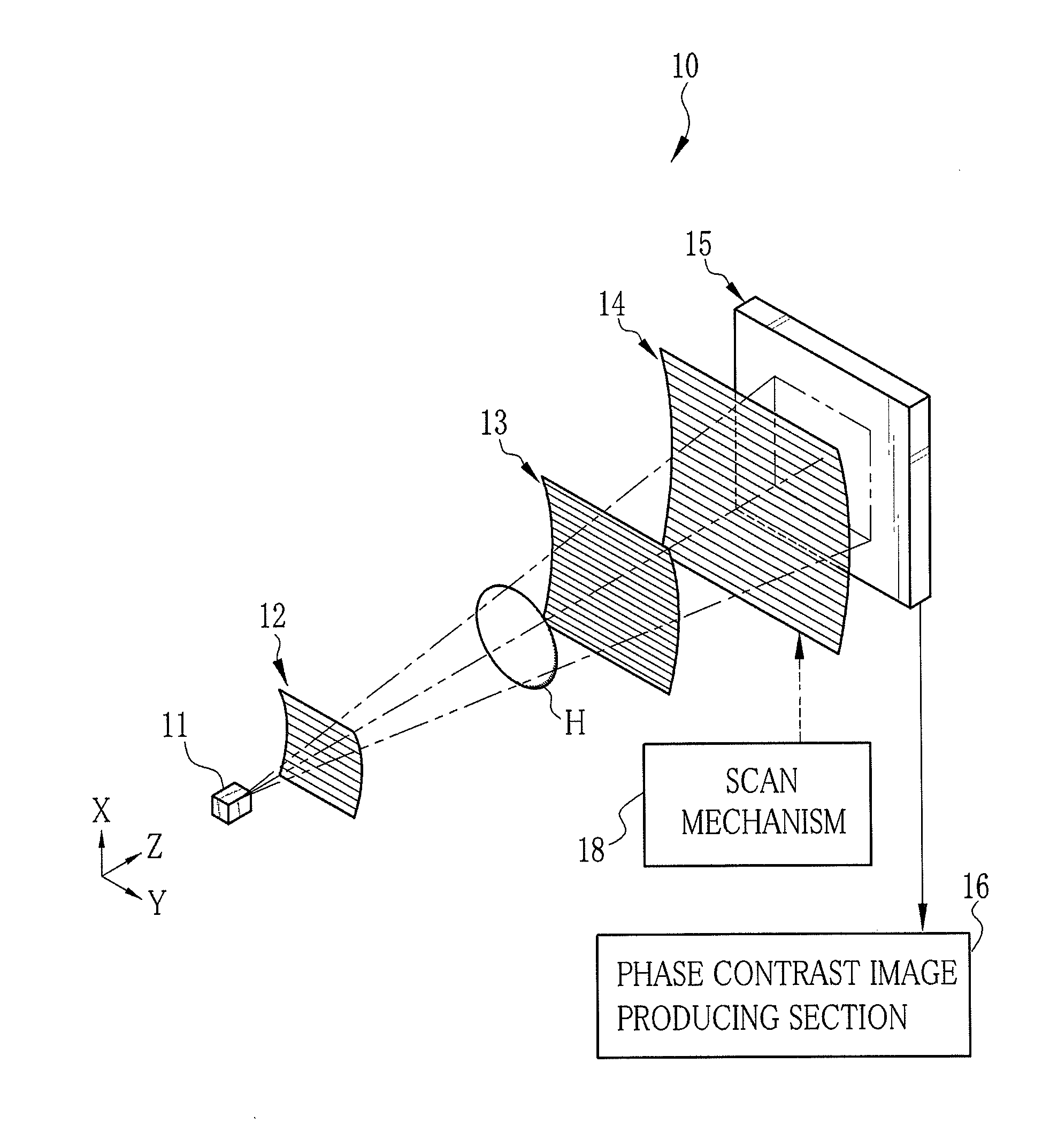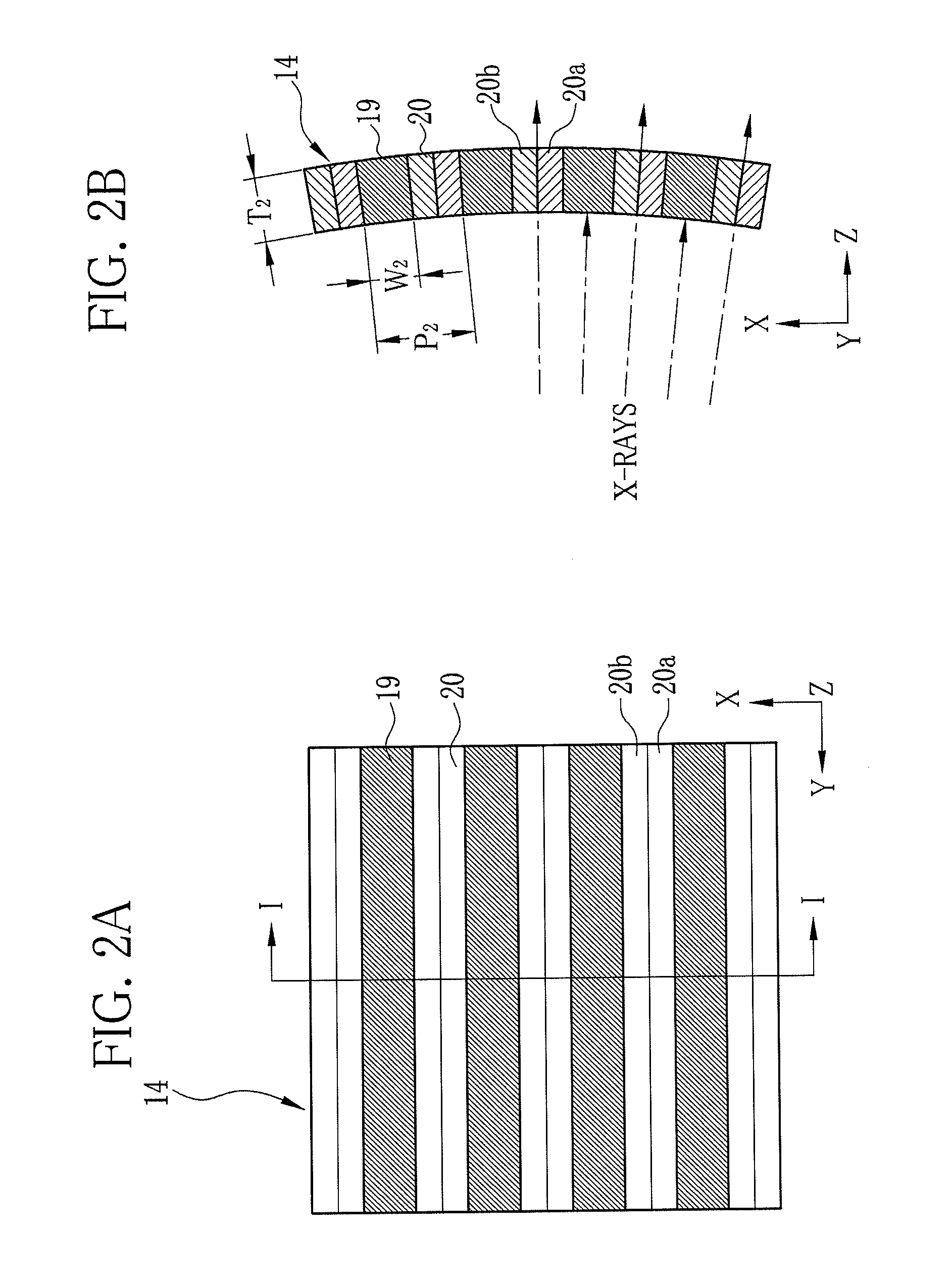Grid for radiography and manufacturing method thereof, and radiation imaging system
a radiography and grid technology, applied in the field of grid for radiography, and the manufacturing method of the grid, can solve the problems of difficult handling of sheets, inability to neatly laminate sheets without gaps, and inability to detect the vignetting of x-rays, so as to prevent diffusion and improve the grid performance. , the effect of high grid performan
- Summary
- Abstract
- Description
- Claims
- Application Information
AI Technical Summary
Benefits of technology
Problems solved by technology
Method used
Image
Examples
first embodiment
[0044]As shown in FIG. 1, an X-ray imaging system 10 is constituted of an X-ray source 11, a source grid 12, a first grid 13, a second grid 14, and an X-ray image detector 15 that are arranged in a Z direction being an X-ray propagation direction. The X-ray source 11 has, for example, a rotating anode type X-ray tube and a collimator for limiting an irradiation field of X-rays, and applies a cone beam of X-rays to a sample H. The X-ray image detector 15 is a flat panel detector (FPD) composed of semiconductor circuitry, for example, and is disposed behind the second grid 14. The X-ray image detector 15 is connected to a phase contrast image producing section (computing section) 16, which produces a phase contrast image from image data detected by the X-ray image detector 15.
[0045]The source grid 12, the first grid 13, and the second grid 14 are X-ray absorption grids, and are opposed to the X-ray source 11 in the Z direction. The first grid 13 is disposed at a certain distance away ...
second embodiment
[0070]In the above first embodiment, the X-ray transparent portion 20 is composed of the X-ray transparent sheet 20a and the buffer layer 20b. However, as shown in a second grid 40 of FIGS. 8A and 8B, an X-ray absorbing portion 41 may be composed of the X-ray absorbing layer 22 and a buffer layer 42, instead. In this case, an X-ray absorbing material made of gold, platinum, silver, or lead is dispersed into an adhesive for forming the buffer layer 42, in order to impart the X-ray absorptivity to the buffer layer 42. The X-ray transparent sheet 20a is formed so as to have a thickness corresponding with the thickness of an X-ray transparent portion 43. The sum of the thicknesses of the X-ray absorbing layer 22 and the buffer layer 42 corresponds with the thickness of the X-ray absorbing portion 41. The second grid 40 of the second embodiment has the same structure as the second grid 14 of the first embodiment except for the layer structure of the X-ray absorbing portions 41 and the X-...
third embodiment
[0072]In the above embodiments, the grid with the convergence structure is formed by curving the layer laminated sheet 29 sliced out of the roll, but a flat grid with the convergence structure may be formed. A third embodiment of the present invention will be hereinafter described. In the following description, the reference numerals same as those of the first and second embodiments refer to the same components, and detailed description thereof will be omitted.
[0073]As shown in FIGS. 9A and 9B, a second grid 50 according to the third embodiment has the plural X-ray absorbing portions 19 and the plural X-ray transparent portions 20 that extend in the Y direction and are arranged alternately in the X direction. The X-ray transparent portion 20 is composed of the X-ray absorbing sheet 20a and the buffer layer 20b. The second grid 50 has the convergence structure in which the X-ray absorbing portions 19 and the X-ray transparent portions 20 are inclined in the YZ plane so as to converge...
PUM
| Property | Measurement | Unit |
|---|---|---|
| Thickness | aaaaa | aaaaa |
| Shape | aaaaa | aaaaa |
| Transparency | aaaaa | aaaaa |
Abstract
Description
Claims
Application Information
 Login to View More
Login to View More - R&D
- Intellectual Property
- Life Sciences
- Materials
- Tech Scout
- Unparalleled Data Quality
- Higher Quality Content
- 60% Fewer Hallucinations
Browse by: Latest US Patents, China's latest patents, Technical Efficacy Thesaurus, Application Domain, Technology Topic, Popular Technical Reports.
© 2025 PatSnap. All rights reserved.Legal|Privacy policy|Modern Slavery Act Transparency Statement|Sitemap|About US| Contact US: help@patsnap.com



